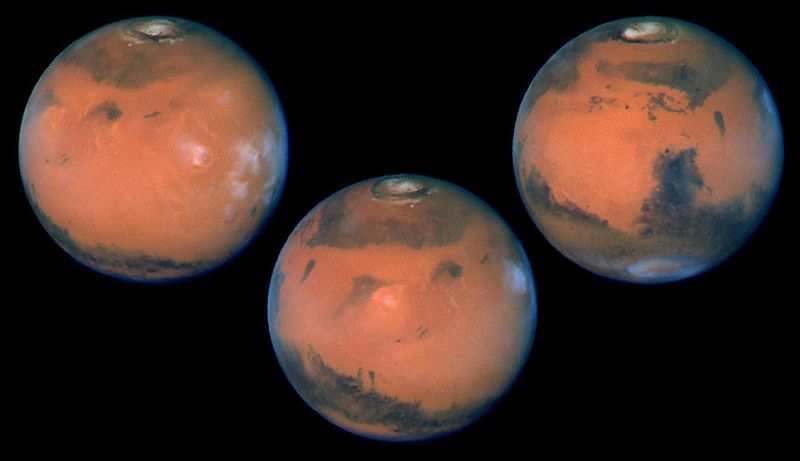English: Pictures of the planet Mars taken with the recently refurbished NASA Hubble Space Telescope (HST) will provide the most detailed global view of the red planet ever obtained from Earth.
The images were taken by HST's Wide Field Planetary Camera-2 on March 10, 1997, just before Mars opposition, when the red planet made one of its closest to the Earth (about 60 million miles or 100 million km).
These pictures were taken during three HST orbits that were separated by about six hours. This timing was chosen so that Mars, with its 24-hour 39-minute day, would rotate about 90 degrees between orbits. This imaging sequence therefore covers most of the Martian surface. These observations will be combined with others planned for March 30 to provide complete coverage.
During each orbit, Mars was observed in nine different colors spanning the ultraviolet to the near infrared. The specific colors were chosen to clearly discriminate between airborne dust, ice clouds, and prominent Martian surface features. The color picture shown here was created by combining images taken in blue (433 nm), green (554 nm), and red (763 nm) colored filters. The Martian north pole is at the top (near the center of the bright polar cap) and East is to the right. The center of the disk is at about 23 degrees north latitude, and the central longitudes are near 160, 210, and 305 degrees.
These images show the planet on the last day of Martian spring in the northern hemisphere (just before summer solstice). The annual north polar carbon dioxide frost (dry ice) cap is rapidly sublimating, revealing the much smaller permanent water ice cap. This polar cap remnant, along with a few nearby detached regions of surface frost are most obvious in pictures taken through ultraviolet, blue, and green filters. These filters also show numerous bright water ice clouds. The brightest clouds are in the vicinity of the giant volcanos on the Tharsis Plateau (to right of center on left image), and in the giant impact basin, Hellas (near bottom of right-hand image), but a diffuse haze covers much of the Martian tropics as well.
The familiar bright and dark markings on the Martian surface are most obvious in images taken through red and near-infrared filters. These images clearly reveal the large, dark, circular "sea" of sand dunes (Olympia Planitia) that surrounds the north pole, as well a number of other familiar features, including the giant Tharsis volcanos. The 16-mile (27 km) high Olympus Mons is near the center of the left-hand image, with Arsia, Povonis, and Ascraeus Mons forming a south-west to north-east line just to its right. The volcano, Elysium Mons is near the center of the middle image. The prominent dark feature just below the center on the disk on the rightmost image is Syrtis Major Planitia.
Hubble is being used to monitor dust storm activity to support the Mars Pathfinder and Mars Global Surveyor Orbiter Missions, which are currently en route to Mars. Airborne dust is most easily seen in WFPC2's red and near-infrared images. Weather reports derived from these observations are particularly valuable for Mars Pathfinder, which is scheduled for a July 4, 1997 landing on the red planet. A preliminary analysis of these HST data reveals enhanced dust activity over the dark Vastitas Borealis region in the northern hemisphere, and over the Noachis Terra and Terra Tyrrhena regions just south of the Martian equator. There is also evidence for airborne dust and ice clouds in the Hellas basin. However, these images show no evidence for large-scale dust storm activity.







